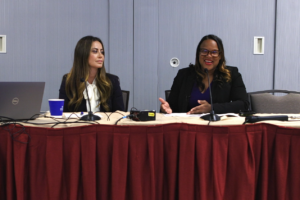CURRENT MONTH (December 2022)
Securities Regulation
C&DI Updates on Non-GAAP Financial Measures
By Gonzalo Go
On December 13, 2022, the staff of the Division of Corporation Finance (“Staff”) of the Securities and Exchange Commission (“Commission”) updated the following Compliance & Disclosure Interpretations (“C&DI”) on Non-GAAP Financial Measures:
- In old Question 100.01, the Staff noted it would be misleading (and a violation of Rule 100(b) of Regulation G) to present a non-GAAP performance measure that excludes “normal, recurring, cash operating expenses” necessary to operate a registrant’s business. Updated Question 100.01 clarifies that (a) “normal, operating expense” is determined by considering the nature and effect of the non-GAAP adjustment and how it relates to the company’s operations, revenue-generating activities, business strategy, industry, and regulatory environment, and (b) a “recurring” operating expense is one that occurs repeatedly or occasionally, including at irregular intervals.
- Old Question 100.04 illustrated a potential violation of Rule 100(b) of Regulation G through misleading non-GAAP measures (e.g., an individually tailored revenue recognition and measurement method) that substituted those prescribed by GAAP. Updated Question 100.04 elucidates this point by providing two additional examples.
- New Question 100.05 advises that, and provides some examples on how, a non-GAAP measure can be misleading to investors and would violate Rule 100(b) of Regulation G if it, and/or any adjustment made to the GAAP measure, is not appropriately labeled and clearly described.
- New Question 100.06 clarifies that a non-GAAP measure can still be misleading, and violate Rule 100(b) of Regulation G, even if accompanied by disclosure about the nature and effect of each adjustment made to the most directly comparable GAAP measure.
- Old Question 102.10 is renumbered and is now Question 102.10(a), which includes updated samples of non-GAAP measures that are more prominent than the comparable GAAP measures. These samples are consistent with Item 10(e)(1)(i)(A) of Regulation S-K’s requirement to present the most directly comparable GAAP measure with equal or greater prominence when a registrant presents a non-GAAP measure, particularly when presented in documents filed with the Commission and in earnings releases furnished under Item 2.02 of Form 8-K.
- A new Question 102.10(b) shares some sample disclosures that would cause the non-GAAP reconciliation required by Item 10(e)(1)(i)(B) of Regulation S-K to give undue prominence to a non-GAAP measure.
- A new Question 102.10(c) explains that an income statement that is comprised of non-GAAP measures and includes all or most of the line items and subtotals found in a GAAP income statement is considered a “non-GAAP income statement” which, by itself or as part of the required non-GAAP reconciliation, gives undue prominence to non-GAAP measures.
The text of the updated C&DIs on Non-GAAP Financial Measures may be viewed here, and the comparison against their earlier version may be viewed here.
SEC Staff Provides New Universal Proxy Guidance
On December 7, 2022, the Staff of the Securities and Exchange Commission issued three Compliance and Disclosure Interpretations that address the universal proxy rules. These are included in the Staff’s Proxy Rules and Schedule 14A Compliance and Disclosure Interpretations as Questions 139.04, 139.05, and 139.06.
Sample Letter to Companies Regarding Recent Developments in Crypto Asset Markets
Last week, the Staff of the Division of Corporation Finance of the Securities and Exchange Commission posted a sample comment letter (see the sample letter) in order to provide guidance to reporting companies regarding the types of disclosures that reporting companies should consider to the extent that a filer has been impacted by a bankruptcy or by the financial distress of a crypto asset market participant. In its communication, the Staff noted that recent events have caused “widespread market disruption.” As a result, some companies may be impacted and should evaluate their disclosures in order to provide investors with appropriate, tailored, company-specific discussions of the impact of such events on the company’s business, operations, and future operating results.
To that end, and with a view toward assisting reporting companies, the illustrative comment letter includes sample comments that the Staff of the Division might issue. The sample comments are intended to trigger a review by filers of their disclosures in advance of year-end filings and prompt them to make necessary changes. The Staff notes that the comments are not intended to represent an exhaustive list of issues that ought to be considered but are rather intended to provide an indication of the types of issues that should be taken into account. In addition, the Staff notes that these comments should be considered in connection with disclosure documents that may not typically be subject to review by the Division before use, such as automatically effective registration statements and prospectus supplements for takedowns from effective shelf registration statements.
The comments address such matters as the following:
- Disclosure of significant crypto asset market developments material to an understanding of the business, financial condition, and results of operations.
- To the extent material, how the bankruptcies of XX and XX and the downstream effects of those bankruptcies have impacted or may impact the company’s business, financial condition, etc.
- If material, the company’s direct or indirect exposures to other counterparties, customers, custodians, or other participants in crypto asset markets known to: have filed for bankruptcy, been decreed insolvent or bankrupt, made any assignment for the benefit of creditors, or have had a receiver appointed for them; have experienced excessive redemptions or suspended redemptions or withdrawals of crypto assets; have the crypto assets of their customers unaccounted for; or have experienced material corporate compliance failures.
- If material, steps taken to safeguard customers’ crypto assets.
- Policies and procedures in place to prevent self-dealing and other potential conflicts of interest.
- Policies and procedures on the commingling of assets, including customer assets.
- Any excessive redemptions or withdrawals, or suspensions of redemptions or withdrawals, of crypto assets and the potential effects on financial condition and liquidity.
- Material risks to the company, either direct or indirect, due to excessive redemptions, withdrawals, or a suspension of redemptions or withdrawals, of crypto assets.
- To the extent material, any reputational harm the company may face.
- Material risks arising from regulatory developments related to crypto assets and crypto asset markets.
- Identify material pending crypto legislation or regulation and any material effects on the business, financial condition, and results of operations.
- Material risks related to the assertion of jurisdiction by U.S. and foreign regulators and other government entities over crypto assets and crypto asset markets.
- Material risks related to safeguarding the company’s, affiliates’, or customers’ crypto assets.
- Material risks to the business and financial condition if policies and procedures surrounding the safeguarding of crypto assets, conflicts of interest, or comingling of assets are not effective.
- To the extent material, any gaps the board or management have identified with respect to risk management processes and policies in light of current crypto asset market conditions as well as any changes made to address those gaps.
- Material financing, liquidity, or other risks encountered related to the impact that the current crypto asset market disruption has had, directly or indirectly, on the value of the crypto assets used as collateral or the value of crypto assets used by others as collateral.
- To the extent material, any of the following risks due to disruptions in the crypto asset markets: risk from depreciation in stock price; risk of loss of customer demand for products and services; financing risk; risk of increased losses or impairments in investments or other assets; risks of legal proceedings and government investigations, pending or known to be threatened, in the United States or in other jurisdictions against the company or its affiliates; or risks from price declines or price volatility of crypto assets.
PCAOB Secures Complete Access to Inspect and Investigate Chinese Audit Firms, but SEC Signals Must Remain Vigilant
By Jason T. Elder, Thomas Kollar, Andrew J. Olmem, Anna T. Pinedo & Ruchira Podali
On December 15, 2022, the US Public Company Accounting Oversight Board (“PCAOB”) announced it had secured complete access to inspect and investigate issuer engagements of audit firms headquartered in China and Hong Kong, marking the first time in history that Chinese authorities allowed complete access for inspections and investigations meeting US standards.
Under the Sarbanes-Oxley Act, the PCAOB is responsible for inspecting and investigating registered public accounting firms around the world. However, its access to inspect and investigate such firms in mainland China and Hong Kong has been impeded.
Read the complete Legal Update.
SEC Adopts Amendments to Rule 10b5-1
By Nicholas Martini, J.D. Candidate, Class of 2023, George Mason University – Antonin Scalia Law School
On December 14, the SEC unanimously adopted amendments to Rule 10b5-1, the pre-arranged trading plans rule, to “address concerns about abuse of the rule to trade securities opportunistically on the basis of material nonpublic information in ways that harm investors and undermine the integrity of the securities markets.” The amendments add four major requirements to claim the affirmative defense to insider trading under Rule 10b5-1(c):
- First, trading plans by directors and Section 16 officers of an issuer must include a cooling-off period for plan adoptions and modifications. Trades under the plan are prohibited until the later of either: (a) ninety days after adoption or modification, or (b) two business days after the issuer discloses, in Form 10-K or 10-Q, its financial results for the fiscal quarter in which the plan was adopted or modified, but not to exceed 120 days after adoption or modification. Other insiders (other than issuers) are subject to a thirty-day cooling-off period for plan adoptions and modifications. Issuers are not subject to cooling-off periods.
- Second, directors and Section 16 officers must include a representation in their plans certifying that at the time of adoption or modification: (a) “they are not aware of any material nonpublic information about the issuer or its securities” and (b) “they are adopting the plan in good faith and not as part of a plan or scheme to evade the prohibitions of Rule 10b-5.”
- Third, for all persons other than issuers, the amendments remove the affirmative defense for multiple, overlapping plans and limit the ability to rely on the affirmative defense for a single-trade plan (a plan that covers a single trading event) to one plan per twelve-month period. But, the amendments allow for certain accommodations, including allowing for multiple 10b5-1 plans for qualified “sell-to-cover” transactions and using more than one broker to facilitate trades under a single plan.
- Fourth, the amendments require that the person entering into the plan act in good faith with respect to the plan after adoption. This applies to all persons entering into Rule 10b5-1 plans, including issuers.
Furthermore, the amendments require issuers to provide several new disclosures. Among others, issuers are required to disclose (a) their insider trading policies and procedures; (b) details about any “Rule 10b-1 trading arrangement” or “non-Rule 10b5-1 trading arrangement” entered into by a director or Section 16 officer during each completed fiscal quarter; and (c) policies and practices on the timing of awards of stock options, SARs, and/or similar option-like instruments in relation to the disclosure of material nonpublic information (MNPI), alongside new tabular disclosures about awards made to named executive officers within certain days of the release of MNPI. The amendments also affect Section 16 reporting, including that Section 16 insiders are required to (a) indicate on Forms 4 or 5 by checkbox whether a reported transaction was intended to satisfy the affirmative defense under 10b5-1(c) and (b) report dispositions via bona fide gifts of securities within two business days on Form 4.
The amendments become effective on February 27, 2023. Section 16 reporting persons must comply with the Forms 4 and 5 amendments beginning with the first reports filed on or after April 1, 2023. Issuers must comply with the new disclosure requirements in the first filing that covers the first full fiscal period that begins on or after April 1, 2023. Smaller reporting companies have an additional six months to comply with the new disclosure requirements.








